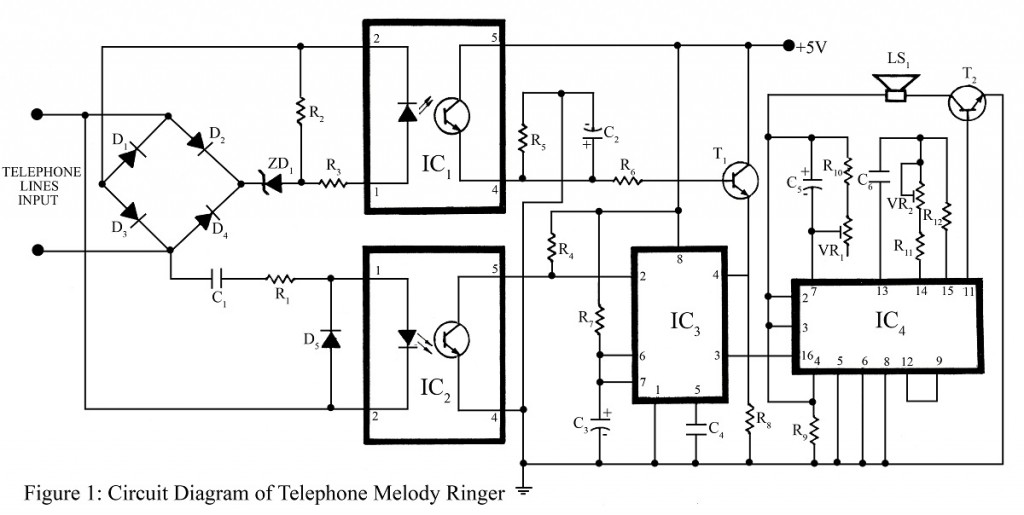Telephone ringer circuit using 555 IC is a simple circuit or device which produces an alerting sound whenever a call is placed to your telephone number.
The Telephone project posted here is the a telephone ringer which produces pleasant tunes when a call is placed to your number. The tunes produced by “telephone ringer” here are more melodious and soothing compare to those of old telephone instrument and piezo buzzer in the current electronic telephone instruments.
PARTS LIST OF TELEPHONE RINGER CIRCUIT USING 555 IC
|
Resistors (all ¼-watt, ± 5% Carbon) |
|
R1 = 1.5 KΩ R2, R5 = 100 KΩ R3, R10 = 10 KΩ R4, R8 = 1 KΩ R6 = 270 Ω R7 = 1 MΩ R9 = 4.7 KΩ R11 = 47 KΩ R12 = 68 KΩ VR1, VR2 = 10 KΩ (pot.) |
|
Capacitors |
|
C1 = 0.47 µF (ceramic disc) C2 = 2.2 µF/10V (electrolytic capacitor) C3 = 47 µF/10V (electrolytic capacitor) C4 = 0.1 µF (ceramic disc) C5 = 2.2 µF/10V (electrolytic capacitor) C6 = 47 pF (ceramic disc) |
|
Semiconductors |
|
IC1 = MCT2E IC2 = 4N33 IC3 = NE555 IC4 = UM3481 T 1 = 2N3904 T2 = SL100 D1 – D5 = 1N4004 ZD1 = 15V/1W Zener diode |
|
Miscellaneous |
|
LS1 = 8Ω, 250mW |
Working Principle | Telephone Ringer Circuit using 555 IC
The circuit is based on the musical IC UM3481/3482/3483/3484 (IC4). When the telephone senses an incoming cal signal, all the tunes stored in the ROM of the IC (IC4) are played in sequence. The bell stops ringing when handset is picked up.
Circuit Descriptions | Telephone Ringer Circuit using 555 IC
The complete circuit comprises of music IC, timer IC, a pair of opto-coupler followed by few other components as shown in circuit diagram (Figure 1). Diode D1 through D4 configured as bridge rectifier through which telephone line is connected. The bridge rectifier provides correct polarity to the LED inside the opto-coupler of IC1, even if the telephone line is connected in wrong polarity by accident. As we all know that in idle or on-hook condition of telephone, there is about -48 volts DC through the telephone line.
The divider network is formed by combining zener diode ZD1 with resistor R2 which divides the DC voltage from telephone line. The divided voltage is again reduced by resistor R3. The reduced output voltage from resistor R3 is sufficient to light the LED inside IC1. The internal transistor of IC1 only conducts when internal LED glow and also aids transistor T1 to conduct. Hence the supply voltage is extended to the reset pin 4 of timer IC (IC3). The output of IC3 at pin 3 becomes low when the pin 2 is in ‘high’ condition.
Capacitor C1 across the telephone line blocks the DC voltage of about -48 volts (because capacitor blocks DC voltage and can let only AC volts) and prevents it from reaching the telephone ring sensing circuit build around IC2. Diode D5 connected across IC2 protects the internal LED of IC2 during arrival of the ringing signal.
The internal LED of IC2 glow when ringing signal is present and cause internal transistor to conduct, thereby extending ‘low’ to pin 2 of IC3. The timer IC (IC3) is configured as monostable multivibrator. The low input at pin 2 operates and extends a ‘high’ into its output at pin 3. The output of monostable multivibrator is act as power supply for the music circuit designed around musical IC (IC4). The output of IC3 is high for a period determined by the value of R7 and C3. During this period, IC4 generates pleasant tunes.
IC3 responds only to the first ring and ignores subsequent rings during the timing cycle because it is configured as monostable multivibrator, and thus allowing IC4 to produces tunes for the entire time period. The potential drop at telephone line becomes 5-6 volts due to the impedance of the telephone instrument when the telephone is answered or is ‘off-hook’. The low potential drop prevents zener diode ZD1 to connect and hence the LED inside IC1 turns off. This, in turn, switches off the internal transistor and transistor T1. When transistor T1 is turned off, the reset voltage at pin 4 of IC3 is removed, which further withdraw the power supply of the music circuit and the melody stopped.
Operation of Music Circuit | Telephone Ringer Circuit using 555 IC
When the output is high at pin 3 of IC3, pin 4 of IC4 triggers it into operation. Resistor R10, variable resistor VR1 with capacitor C5 changes the internal modulation of the music IC. This is done because lets the IC4 to sound like different music instruments such as piano and organ.
Resistors R11, R12, variable resistor VR1 with capacitor C6 determine the frequency of internal oscillator of IC4. These components change the speed of tempo of tune. Variable resistor VR2 is used to adjust the speed at which the tune is played. Larger and lower the value of capacitor C6 slows and increases the speed of the beat.
The output of IC4 from pin 11 is given to base of NPN transistor T2, which amplified in order to drive the speaker.
Note: While testing the circuit “Telephone Melody Ringer” in LAB we found that the main drawback of this circuit is, sometimes during dialing a melodeous tone may be heard.
